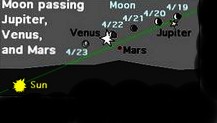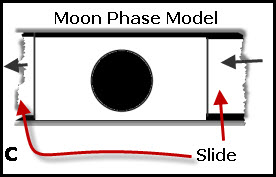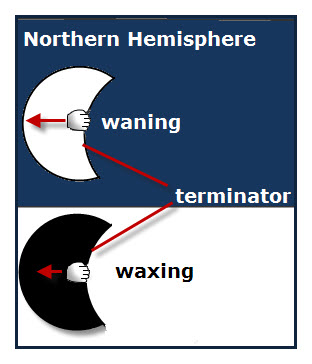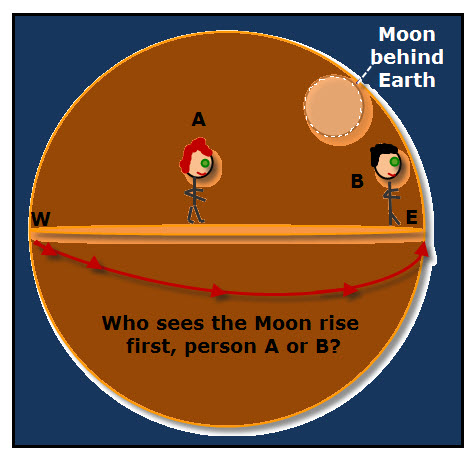Telescopes and binoculars are called optical instruments. These instruments increase the power of human vision. Telescopes and binoculars help you see thing that are at a distance from you. The part of the telescope or binoculars you look through is called the eye piece. The opposite end is called the objective end. The size of […]
The Big Race
I found a great astronomy site, THE CURIOUS SKY WATCHER. The diagram shown is from this site. For more information about the position of the celestial bodies described on this page, check out this site. The Sun, Moon, and planets appear to be in a never ending race from east to west across the southern […]
Pluto Demoted
Pluto has been demoted from being a planet to being a dwarf planet. On Aug. 24, 2006 , the International Astronomical Union (IAU) gave a description for dwarf planets. A dwarf planet is a celestial body that: orbits a sun has enough mass to give it a nearly round shape is not a satellite of […]
Moon Illusion
A fourth grade student recently asked me why the Moon and the Sun seem to follow her no matter where she goes. This is a question asked by many kids, and it is one that is not the easiest to explain. After all, Einstein’s Theory of Relativity is based on where the observer is and […]
Vernal Equinox
On the equinox, the sun is above the horizon for 12 hours, thus the length of daylight and nighttime are equal. This means every location on Earth has 12 hours of daylight and 12 hours of nighttime. If the equinox follows winter, it is called the vernal equinox and is the first day of spring. […]
Why The Sun Changes Color
Everything about life has to do with science, even the beautiful colors of the sky and the Sun at sunsets and sunrises. Actually the Sun is white. This is because the hot Sun emits all the visible colors of light and when blended together they form white light. Maybe a better way of saying this […]
Sun-Earth-Moon Model
Let’s Make a Sun-Earth-Moon Model Astronomy is the study of stars, planets, moons, and other celestial bodies in the universe. The vast size and distance between celestial bodies is not easy to understand especially if kids have not mastered basic distance measurements. Many kids understand distance in terms of how long it takes to get to […]
Moon:Terminator Model
Comparison Science Project Does the Moon’s terminator move differently when viewed from Earth’s Northern and Southern Hemispheres? Terminator Research If you live in the Northern Hemisphere, correspond with someone who lives in the Southern Hemisphere. The diagram is an example for collecting information in the Northern Hemisphere. The white circle, would be shaded to represent […]
Moon: Terminator Motion
Where Is the Moon’s Terminator? How Does the Terminator Appear to Move? As viewed from the Northern Hemisphere, the full moon phase appears to be a white disk-shaped object in the night sky. From one day to the next, the white disk changes shape as the white, lighted part decreases. The line separating the lighted […]
Moon Illusion
Apparent Distance A fourth grade student recently asked me why the Moon and the Sun seem to follow her no matter where she goes. This is a question asked by many kids, and it is one that is not the easiest to explain. After all, Einstein’s Theory of Relativity is based on where the observer […]
- 1
- 2
- 3
- …
- 5
- Next Page »








